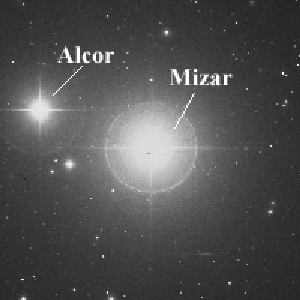
|
Finding Chart for Mizar &
Alcor |
Optical Pairs
Every star in the sky is at a different distance from the Earth. Sometimes stars appear to be side-by-side creating the illusion of a binary star. In fact they may be unrelated to each other with one being closer than its appearent neighbor. In other word these stars are in the same direction in space but at different distance. Therefore they are not gravitationally bound to each other and no orbital motion can be observed.
Mizar and Alcor form such an optical pair. Both stars are members of the Ursa Major Group of stars and so travel together is space as group members. However, Alcor is farther away than Mizar and there is no measureable orbital motion. (CAREFUL! Brighness differences do not always indicate distance differences. One star may be actually brighter even though is clsoer than some other star.)
Mizar is middle star in the handle of the Big Dipper. At 2.40 magnitudes it is easily seen even in light polluted city skies. Alcor lies 11.8 arcmin to the northeast of Mizar. Alcor has a magnitude of 4.02 and is more difficult to see in light polluted skies, but can be viewed in suburban skies. This beautiful pair is commonly known as the "Horse & Rider". Native American cultures have used this pair to test the eyesight of their young "Braves". On the next clear night you should try to view this lovely pair of stars with your own eyes.
Physical or Gravitational Binaries
The binary star to the right is known as STF 1745 and is a true binary star. These two stars orbit a common center of mass and are gravitationally bound to each other. unlike optical doubles these two stars are at the same distance from Earth. So the brighter star, the primary, is actually brighter than the secondary, the fainter star.
Diagram explaining astrometric binaries should go here.
Astrometric Binaries
Astrometric binaries are gravitaionally bound stars but they are too close together to be resolved as two stars or the secondary is too faint to be visible. Because they orbit a common center of mass both stars orbit each other. n the case of astrometric binaries the visible tars appears wiggle back and forth in a peridic manner. Thus it is infered that the visible star is being tuged gravitationally by an unseen more massive companion star.